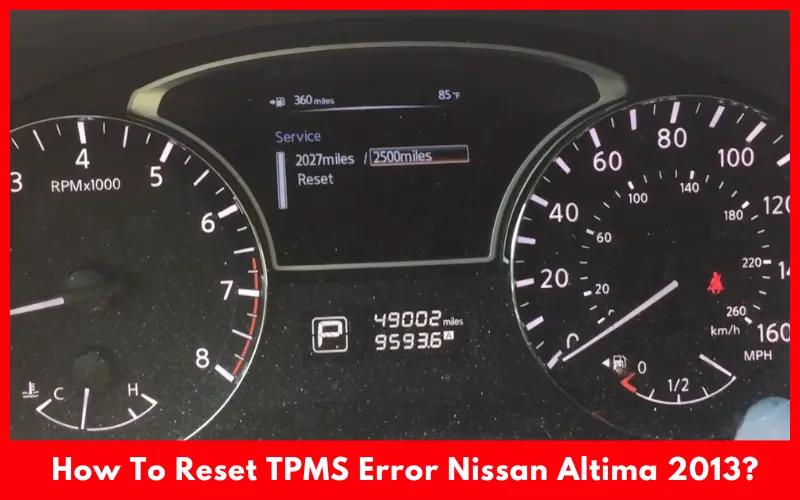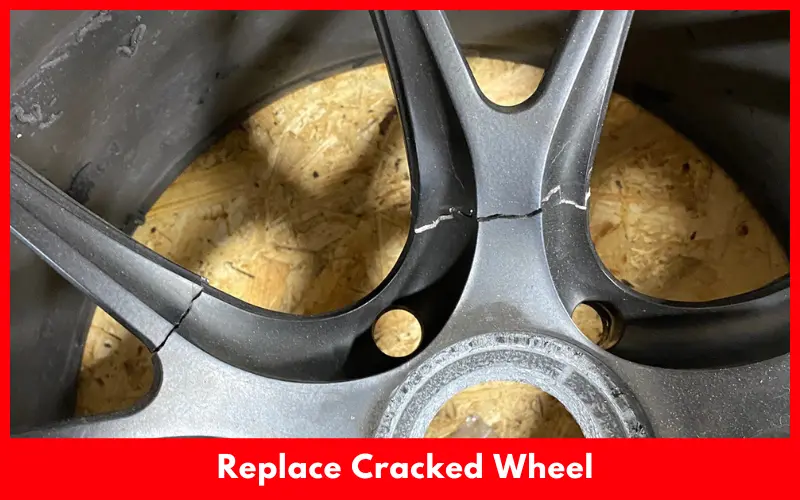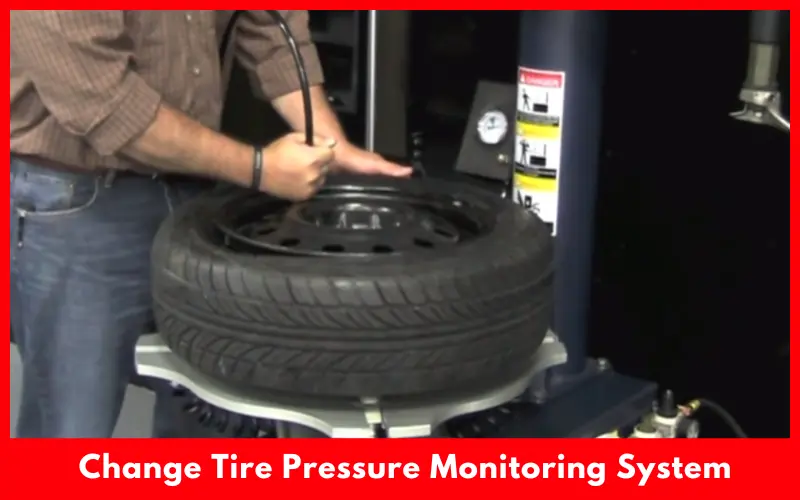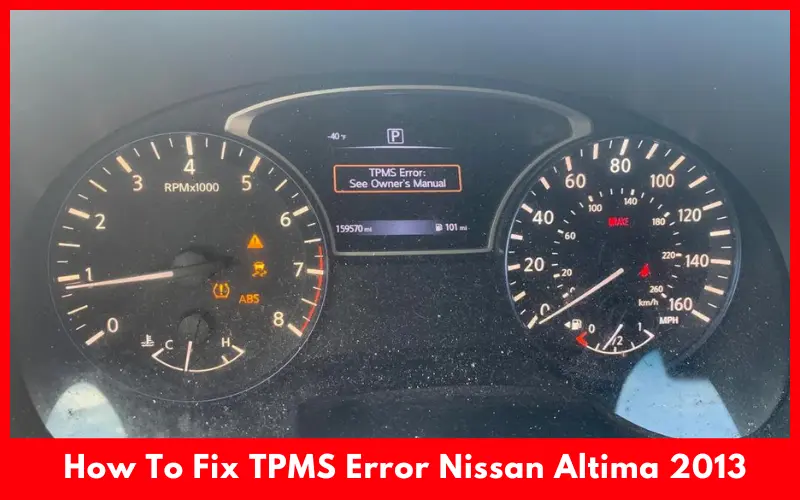TPMS error message can flash on the Nissan Altima 2013 due to incorrect air pressure on tire, cold weather or using a spare tire without reprogramming. If you learn how to fix TMPS error on Nissan Altima 2013, you can solve the problem as it is simple to fix at home garage.
You can remove TPMS error light on Nissan Altima 2013 by ensuring right air pressure on each tire and resetting the sensor. If an internal problem like a cracked wheel, a leaked tire, or a faulty sensor triggers the error light, you’ll need expert help to repair or replace faulty parts to remove the warning light.
Article Summary
What Does TPMS Error Nissan Altima 2013 Mean?
Each tire of Nissan Altima has sensors that report pressure to vehicle system. When system detects tire pressure outside perimeter, it throws a TPMS error: see the owner manual warning light. Tire pressure can change drastically due to cold weather, air leaks, or faulty wheels.
In most cases, self system should reset the error light particularly when cold weather or faulty sensors trigger the issue.
If not, you’ll have to reset or reprogram the system using TPMS tool and scanner. But if your car has an internal issue like a faulty TPMS sensor, or damaged TPMS control module, resetting the system won’t fix the issue. In this case, you have to take the car to a dealer or auto repair shop for diagnosis.
How To Reset TPMS Error Nissan Altima 2013?
You can reset the TPMS error in plenty of ways including:

1. Driving Method
TPMS error lights mostly come on due to low tire pressure. So the light should go off automatically after re-inflating the tires. But if error light remains, follow this driving method to remove light from dashboard:
- Drive your car over 50 mph for around 10 minutes. This will start resetting the sensor next time you’ll turn on the car.
- Turn off the vehicle and rotate the ignition key to on position. Don’t start the vehicle. Hold TPMS reset button placed under steering wheel until the error light blinks 3 times. Then release the button.
- Turn on the vehicle and wait around 20 minutes so the system can refresh the sensor. Once done, turn off the vehicle again.
- Inflate all tires including the spare tire over 3 PSI than recommended. Then re-inflate tires with recommended PSI. Nissan Altima should have between 32 to 33 PSI tire pressure on both front and rear tires.
- Disconnect positive cable from battery terminal using a wrench. Start the vehicle and apply horn for around 3 seconds to discharge stored power in the car. Reconnect positive cable to the battery and turn on the car. You shouldn’t notice the TPMS error light anymore.
- If you still have an error light, inflate tires again with 3 PSI more than recommended. Then deflate the tires and re-inflate them to recommended level.
2. Hard Start the Vehicle
You can also reset TPMS error light by cutting off the power. To do this, disconnect battery keeping the car off. Then turn key to off position and honk the horn for around 3 seconds. Then reconnect the battery and start the car. This should reset TPMS sensor.

3. Inflating Individual Tires
You can also reset TPMS error using a harness connector under the driver’s side dashboard. This method is more tiresome and time-consuming than other techniques. You’ll need to set each tire at a different but specific PSI and drive the car. Then you have to use trigger tool even after installing a new TPMS sensor to disappear the error light.

The location on which you’ll get the error code will indicate the location of registered TPMS sensor. For example, if you programmed sensor at left front wheel and then rotated to left rear without reprogramming, the sensor gets damaged and triggers an error code for left front sensor where it was last registered.
If so, you have to register or program using TPMS trigger tool and scan tool. You can also take aid of a dealer, tire shop, or auto repair shop to program the sensor.
How To Fix TPMS Error On Nissan Altima 2013?
If any internal issue triggers the TPMS error light on your Nissan Altima, resetting the sensor or system won’t disappear the message. In this case, you have to troubleshoot the car to determine the exact intermittent issue and fix it to remove the error light. Below are some possible solutions to fix TMPS error on Nissan Altima:
1. Inflate Or Replace Leak Tire
If TPMS detects a low level of air pressure, it can trigger a warning light due to a slow leak and cause sudden tire failure. If the light is steady, you have to check tire pressure. But if the light is flashing, you need to check the TPMS.

Your car may also display an error message related to the TPMS system. To fix this issue, inflate the tires and then relearn tire pressure monitoring system. If this doesn’t work, replace the leak tire and relearn the system.
2. Replace Cracked Wheel
Air contains water moisture. During inflating tires, compressing air forces this moisture, making it dense. It can form droplets of water inside tire. When TPMS unit detects this droplet, it can trigger the error light.

If so, you’ll notice cracks on wheels, particularly after hitting a large bump. You can also experience vibration while using steering wheel and hear a popping or creaking noise. To fix this use, you have to replace the faulty wheel.
3. Change Tire Pressure Monitoring System
TPMS can fail due to a damaged or drained-out battery. When computer detects that the TPMS sensor has ceased to deliver data, it’ll TPMS warning light. At a time, TMPS will also fail to report correct tire pressure.

It can leave a flat tire unrecognized and provide a high or low tire pressure warning even with a properly inflated tire. If so, you have to replace damaged battery and TPMS sensor. A faulty TPMS control module also causes failure to alter over-inflation or under-inflation. So you should also check TPMS control module to successfully fix TPMS error.
4. Diagnose Tire Pressure Monitor Lamp
If you notice a TPMS error message on a Nissan Altima when a tire has correct air pressure, diagnose and repair the tire pressure monitor lamp.
Why is TPMS Sensor is Not Resetting On Nissan Altima 2013?
TPMS sensor won’t reset if you use a cheap wheel sensor on your Nissan Altima. If so, check the wheel sensor and replace the set with high-quality ones and reprogram if find low quality or damaged. Bad BCM can also prevent tire pressure sensor from resetting.
To verify, perform an ECU code readout using a scanner to get and fix the fault code. TPMS error code starts with C and has 4 more digits. You may need an advanced scan tool to access the TPMS system. If the computer gets a false reading, sensor will also reset. Computer may get a false code due to a defective temp sensor on CVT transmission.
FAQs
How Much Does it Cost To Replace A TPMS Sensor On A Nissan?
On average, it costs around $50 to $200 to replace TPMS sensor per tire. The cost can be higher if your car requires more advanced sensors and you bring the car to dealership.
Does Nissan 2013 Have A Recall On TPMS Sensor?
No, Nissan Altima doesn’t have a recall on TPMS sensor. However, Nissan has recalled sensors within passenger ODS that cause system to malfunction and suppress passenger airbag permanently. The other models included in the list are Nissan Sentra, LEAF, Infiniti, and Pathfinder.
How To Avoid TPMS Error Nissan Altima 2013?
The simplest way to avoid TPMS errors on Nissan Altima is to maintain recommended air pressure on each tire. So check tire pressure regularly and avoid driving over potholes. Make sure battery is fully charged and drive carefully on rough roads. Check TPMS system periodically to maintain its optimum performance and avoid error light.
Final Words
After learning how to fix the TPMS error Nissan Altima 2013, hope now you’ll be able to fix this error in your home garage. If a simple problem triggers the error light, your car self-learning system will fix the issue.
But if cold weather or tire rotation causes the problem, resetting or reprogramming the sensor will remove the error light. If you still have a warning light, inspect your vehicle with an expert mechanic to determine and solve the underlying root of TMPS error light.

